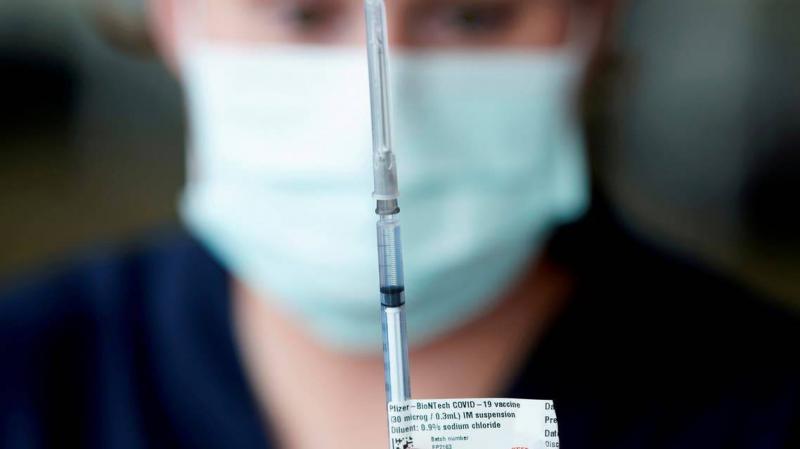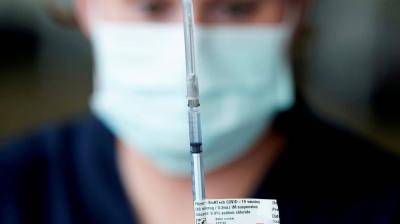The complex manufacturing process carried out by Pfizer to produce the COVID-19 vaccine takes about 60 days, through three factories located in different American states, to complete the production stages under nearly impossible conditions before distribution. The steps are as follows:
### Stage One: Extraction of DNA
A scientist removes vials of DNA from the cell bank, which is the primary source for every batch of Pfizer's COVID-19 vaccine. The vials are stored at a temperature of minus 150 degrees Celsius (-238 degrees Fahrenheit) or lower. These genetic codes contain small loops of DNA called plasmids, with each plasmid carrying the genetic code for the coronavirus, representing the genetic instructions for a human cell to build coronavirus proteins and stimulate an immune response. Scientists thaw the plasmids and modify a strain of bacteria known scientifically as "E. coli" to take the plasmids into their cells. Although this manufacturing process requires only one vial of DNA, it can produce approximately 50 million doses of the vaccine.
### Stage Two: Cell Growth
Despite significant technological advancements, the preparation of the active ingredient in Pfizer's COVID-19 vaccine is done manually. Scientists place the vial of DNA into a medium-sized flask made of amber-colored glass. The DNA is mixed with plasmids and E. coli bacteria in a warm, sterile environment that allows the bacteria to multiply and grow.
### Stage Three: Fermentation of the Mixture
The bacteria are left to multiply overnight and then placed in a large fermentation vessel with approximately 300 liters of nutrient broth for the bacteria. This mixture remains in the fermenter for about four days, with the bacteria multiplying every 20 minutes, creating trillions of copies of the DNA plasmids.
### Stage Four: Harvesting and Purification
Once fermentation is complete, scientists add chemicals to break open the bacteria and release the plasmids from the surrounding cells. The mixture is then purified to remove the bacteria, leaving only the plasmids.
### Stage Five: Quality Testing
The plasmids are tested for purity and compared with previous samples to ensure that the coronavirus gene sequence has not changed.
### Stage Six: Cutting the Plasmids
If the plasmids pass quality tests, proteins called enzymes are added to the mixture to cut the circular plasmids, separating the coronavirus genes into linear segments. This "linearization" process takes about two days.
### Stage Seven: DNA Filtration
In this stage, any remaining bacteria or plasmid fragments are filtered out, leaving one-liter bottles of purified DNA. The DNA sequence is tested again as it will serve as templates for the next phase of the process. Each bottle of DNA will produce approximately 1.5 million doses of the vaccine. The Chesterfield facility is the sole source of Pfizer's plasmids for the COVID-19 vaccine, but completing the vaccine requires several additional steps at two other facilities.
### Stage Eight: Transfer of Plasmids
The prepared vials from the Chesterfield facility are transported to the Andover facility of Pfizer, where each cell of the prepared genes is placed on a messenger RNA (mRNA) carrier for conversion into mRNA technology. Another portion of the vials is sent to the Mainz facility in Germany, operated by BioNTech, the German partner developing the vaccine. To complicate the process further, five vials are opened at a time and allowed to thaw for a full day before being mixed with mRNA. Enzymes open the genetic templates and allow for copying the DNA strand onto the mRNA that will carry it to human cells upon vaccination, prompting the production of proteins similar to the coronavirus that will fight off viruses in infected bodies using the same viral technology. The mixture is then sent to another filter to remove undesirable genetic material, impurities, and excess enzymes, allowing for the production of approximately 7.5 million vaccine doses each time.
### Further Transport
After freezing the vaccines at minus 20 degrees Celsius, they are transported to their final destination in the manufacturing process, which is the Kalamazoo facility in Michigan. The mixture is packaged into the final vaccine vials while samples are sent for retesting at the Chesterfield facility. The Andover facility can produce two batches of the mixture every week, each comprising 10 bags, with each bag containing 16 liters representing the raw material for 750,000 vaccine doses, which means that eventually, about 15 million doses can be produced weekly, as reported by The New York Times.
Recently, Pfizer has doubled its production capacity, along with parallel processing occurring at the Mainz facility in Germany which sends its production to the Brussels facility in Belgium for the European Pfizer-BioNTech vaccines.
### Mixing with Lipids
The bags of the mixture sent from the Andover facility are received at the Kalamazoo plant and placed in water, while scientists in a separate process prepare lipid oils that protect the mRNA and assist its entry into human cells.
### mRNA Assembly
A rack composed of 16 pumps precisely controls the flow of mRNA and lipid solutions, then mixes them to form lipid nanoparticles. When the lipids come into contact with the bare strands of mRNA, the electric charge pulls them together in a nanosecond. The mRNA is coated with several layers of lipids, forming a protective oil structure for the vaccine.
Synchronizing eight pairs of pumps is not an ideal solution, but Pfizer engineers opted to scale up existing technology instead of trying to build a larger, unproven type of mixing device.
### Vial Preparation
Thirteen cameras installed on the vial preparation stage wash and sterilize the vaccine vials, ensuring there are no cracks or foreign bodies by taking around 100 pictures of each vial.
### Filling Vials
Each vial is filled with 0.45 ml of the vaccine, enough for 6 individual doses. The difficulty of this manufacturing process lies in the fact that the Kalamazoo plant has only 46 hours from the moment it receives the mixture from the Andover facility to carry out mixing, filling into vials, and refreezing.
### Storage and Shipping
The filled vials are placed in plastic containers resembling pizza boxes, each containing 195 vials. Every five plastic containers are bundled together and placed in one of Pfizer's 350 industrial freezers, each housing about 300 plastic containers. The vaccine requires about two days to reach a frozen temperature of minus 70 degrees Celsius in these freezers. These vaccines wait for four weeks before being distributed after receiving test results from the samples sent to the Chesterfield facility, the producer of DNA, and the Andover facility, the producer of mRNA, to ensure the vaccine's safety and effectiveness. The production of a single batch of the Pfizer vaccine takes about 60 days from the start of production to distribution, with half of this time associated with vaccine testing.




